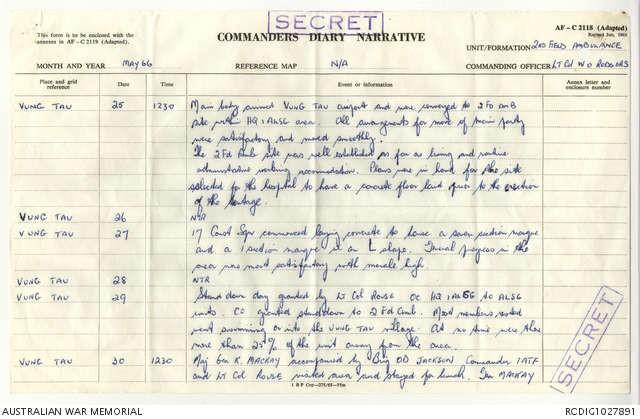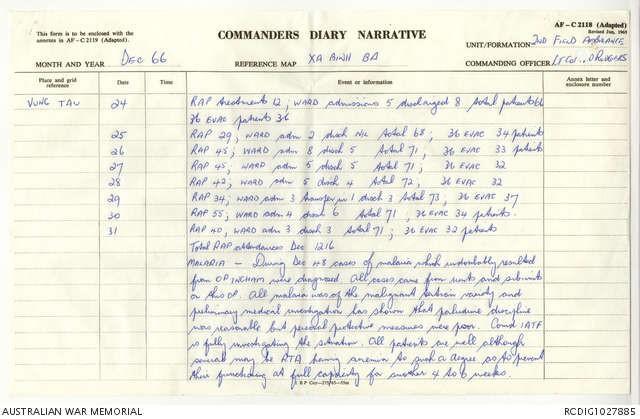Mission of care in the Vietnam War: 2 Field Ambulance, 1966–1967
The Australian Field Ambulance has played a vital role during times of conflict, assessing injuries, providing initial medical care, and removing the wounded from combat zones. During the Vietnam War, 2 Field Ambulance was stationed at Nui Dat and Vung Tau, the first Australian Army medical unit to serve in a war zone since the Second World War. Its war diary illustrates the volume and variety of medical and nursing work undertaken during 1966 and 1967.
The 2 Field Ambulance unit was formed at Puckapunyal before being deployed to Vietnam in May 1966. Initially stationed at Vung Tau, the unit’s personnel lived and worked in huts and tents while a 50-bed hospital was built by engineering units with assistance from 1 Australian Logistics Group.
The unit included a surgical team consisting of a surgeon and an anaesthetist, nurses, a hygiene squad, medical stores, and a purpose built 50-bed hospital component. Surgical staff tended to have had a range of experiences before serving with 2 Field Ambulance. Nurses, however, were recruited primarily from civilian hospitals, and were expected to learn and adapt quickly to their new conditions. Together they faced the challenges of learning to work in unfamiliar tropical conditions, often with limited equipment and supplies.
Tents at Vung Tau, Vietnam
Bruce Fletcher, oil on canvas board, 1967. ART40561.
Temporary accommodation for the officers of 2 Field Ambulance, known among enlisted ranks and nurses as “Snob Hill”.
As a front line unit, 2 Field Ambulance staff triaged, assessed and treated patients – providing first aid and undertaking emergency surgery – before they were sent to major hospital units. Field Ambulance staff also provided x-ray facilities and recorded injuries. Patients needing days or weeks of bed rest and rehabilitation were treated at the unit’s 50-bed hospital. While the unit continued a similar type of care as that undertaken by ambulance units in the First and Second World Wars, in Vietnam there was widespread use of dust off helicopters to transport patients to and from ambulance and hospital units. There were also largescale medical-evacuation flights every few months, using RAAF C-130 planes to transport patients to Australia.

Commander’s diary for the 2 Field Ambulance’s arrival in Vung Tau, Vietnam, May 1966.

Commander’s diary, December 1966. Christmas Day is business as usual.
Throughout the deployment, high-level military medical officers and officials visited to learn about the unit’s work, and to meet staff and patients. Senior medical staff led tours of the facilities and demonstrated the processes of the unit. Future prime minister, Malcolm Fraser, visited the unit when serving as Minister for Army in 1966. Red Cross and Salvation Army staff also visited, primarily to assist patients in advanced stages of recovery.
Minister for Army Malcolm Fraser visits patients at 2 Field Ambulance, 1966. Photographer unknown. FOR/66/0536/VN.
Red Cross staff help recovering 2 Field Ambulance patients. Photograph by Byron Charles Campbell. CAM/67/0330/VN.
As well as treating Australian patients, the 2 Field Ambulance treated American and New Zealand soldiers, Vietnamese civilians and Viet Cong prisoners of war. As well as being highly regarded by military personnel who had received care, 2 Field Ambulance assisted the Winning Hearts And Minds (WHAM) program by providing medical care to sick and injured Vietnamese civilians.
Tran Van Cuc (Viet Cong Patient)
Bruce Fletcher, oil on canvas on hardboard, 1967. ART40571.
Portrait of Tran Van Cuc, Viet Cong prisoner of war patient, 2nd Field Ambulance, Vung Tau, Vietnam.
In April 1967, 2 Field Ambulance personnel treated their final cases and handed over their buildings, supplies and equipment to 8 Field Ambulance. After a year of service in Vietnam, 2 Field Ambulance returned to Australia on a RAAF C-130, the same type of transport used for patient evacuations.
The unit war diary for 2 Field Ambulance is part of the Australian War Memorial’s Official Records. It has been digitised and is publically available here on the Memorial’s website.



